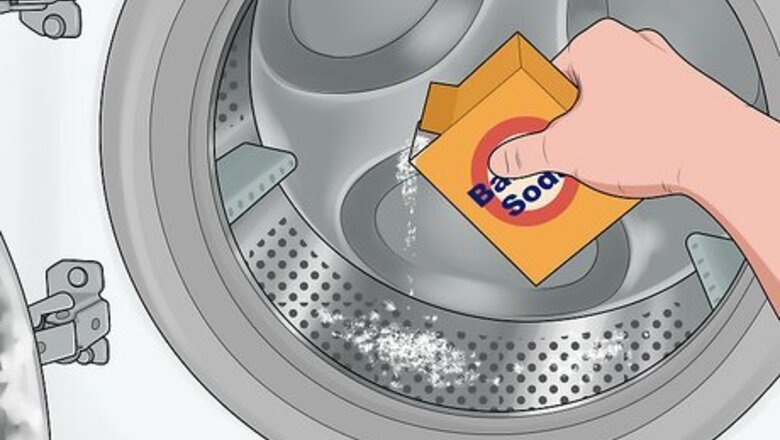
views
- Run a hot water cycle with baking soda and vinegar to clean and deodorize the drum on your front load washer. Alternatively, use bleach for strong odors or mildew stains.
- Remove any debris stuck between the rubber gaskets around the door. Wipe the gaskets with hot soapy water or mildew cleaner to remove buildup.
- Clean the detergent drawer and exterior of the washer with a multi-purpose cleaner. Remove the filter from the bottom corner of the machine and rinse it out.
Washing the Drum

Add baking soda and white vinegar to your washer. Scoop about 2 cups (272 g) of baking soda directly into the front loader’s drum and close the door. Then, pull out your washer’s detergent dispenser drawer and pour in 2 cups (470 ml) of distilled white vinegar. During the cycle, the vinegar and baking soda create a reaction that helps clean the drum of your washer. Baking soda acts as a mild abrasive and deodorizer, so it scrapes away residue and removes the smell of musty mildew. Cleaning with vinegar also deodorizes and disinfects the inside of your washer. If the detergent compartment fills up before using all the vinegar, pour the rest into the pre-wash or fabric softener compartment. If you want to leave a more pleasant smell inside the front load washer, add about 10 drops of lavender essential oil to the vinegar before pouring it in.
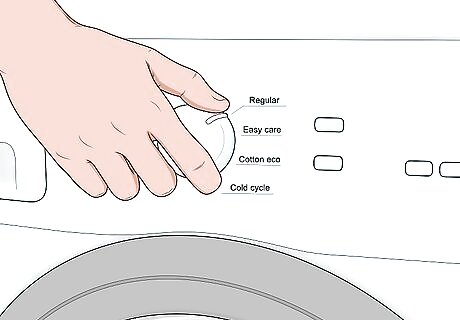
Run your washer on the hottest cycle to clean the mildew inside. If your machine has a cycle specifically for cleaning, then use that setting. Otherwise, a regular cycle with the hottest water setting works just fine. Start your machine, and let the baking soda and vinegar run through the wash to remove any buildup inside your washer. As an alternative to vinegar and baking soda, toss a washing machine cleaning tablet into the drum before the cycle to break down residue. If your washer has a cleaning cycle, the owner's manual may list specific instructions about when to add the vinegar and baking soda. Be sure to read through the manual so you clean your machine properly.
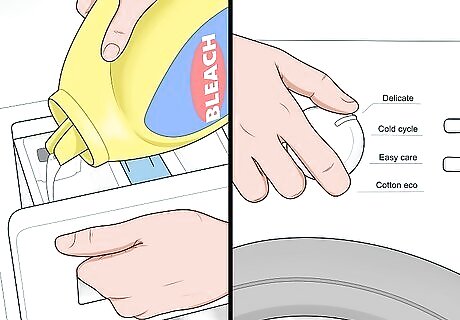
Run a cycle with chlorine bleach to treat musty odors and mildew stains. If your machine is very smelly or if you see large mildew stains, load 2 cups (470 ml) of bleach into the dispenser drawer’s bleach compartment. Run the hottest wash and rinse cycle available on your machine. If it’s possible, pause the cycle after the machine fills with water and let it sit for 30 minutes. Let the cycle finish, and run one more hot rinse cycle to get rid of any residual bleach or mildew. Avoid combining bleach with vinegar since it could create toxic chlorine gas. If you already used vinegar, run an additional rinse cycle before adding bleach.
Cleaning the Gasket
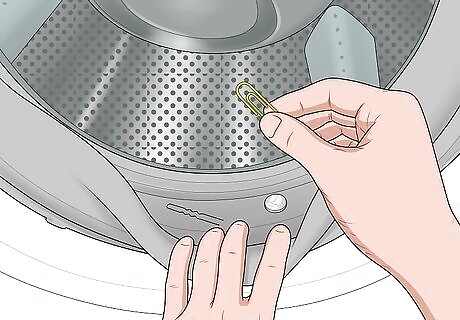
Remove any foreign objects or debris stuck in the gasket. Open the door to your washing front-loading washing machine and locate the ring-shaped rubber gasket that runs along the edges of the opening. Peel apart the rubber flaps to check for any objects that got stuck between them. Common objects you may find include loose hairs, bobby pins, coins, paper clips, and even socks. Scoop the items out and dispose of them properly so they don’t damage the gasket or washing machine during the next cycle. While you’re sorting your laundry, check and empty the pockets on your clothes so it’s less likely for items to get stuck in the gasket. Put on a pair of rubber gloves if you don’t want to touch any residue or mildew with your bare hands. Avoid pulling the gasket apart with a lot of force so you don’t accidentally damage the seal.
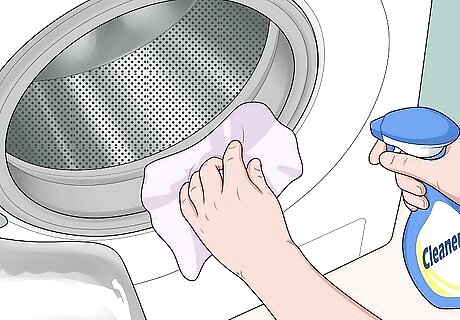
Wipe the gasket with hot soapy water or mildew cleaner. Either use a mix of hot water and dish soap in a spray bottle or a commercial cleaner to treat mildew. Spray the cleaning solution directly onto the gasket, making sure it gets between the flaps of rubber. Then, wipe the cleaner up with a towel or cloth. You may need several cleaning cloths if the gasket is coated with slimy mildew. Just keep spraying and wiping the gasket until your cloth comes away clean. Mildew grows on the gasket when it isn't getting dry enough between uses or when your soap leaves behind too much residue.
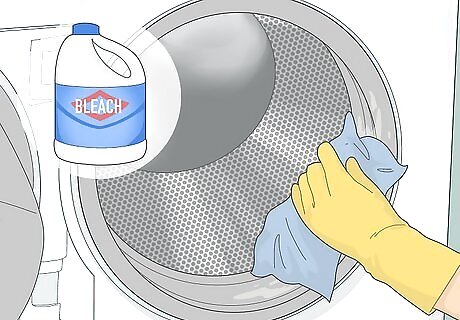
Deep clean the gasket with bleach once a month to kill mildew. Start by diluting ⁄4 cup (180 ml) of chlorine bleach into 1 gallon (3.8 L) of warm water. Put on a pair of rubber gloves and dip a clean cloth into the bleach solution and wipe it over the gasket. Make sure to work the solution in between the flaps of the gasket. After that, dry the gasket off with a fresh cloth. If you've already cleaned the gasket with vinegar, rinse it out thoroughly to remove any residue before using bleach—mixing the two can create a toxic gas. Don’t forget to wipe the inside of the washer’s door to remove stains and mildew from the window glass. If you notice black mold spots that are stubborn and stuck in your gasket, put on a face mask and scrub the area with a toothbrush in a solution dipped in your bleach solution.
Cleaning the Outside of the Machine

Remove and clean the detergent dispenser drawer with soapy water. Pull out the dispenser drawer from the top corner of your front-loading washer. Usually, there’s a button or tab that allows you to completely remove the drawer. Soak the drawer in warm water and dish soap, and scrub any stubborn residue with a toothbrush. Give the drawer a final rinse before drying it off and re-inserting it in your washer. If you’re not able to completely remove the drawer, just try to scrub and wipe the drawer as best as you can with a clean damp cloth.
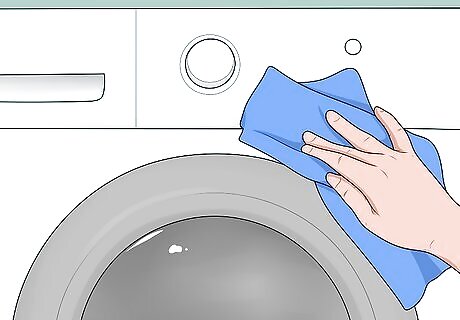
Wipe the outside of the washing machine with multi-purpose cleaner. Spray a clean cloth or rag with your multi-purpose cleaner, and gently wipe along all the exterior surfaces of your washing machine. Clean up any lint, dust, and hair that built up on your washer so it doesn’t get inside of the drum.
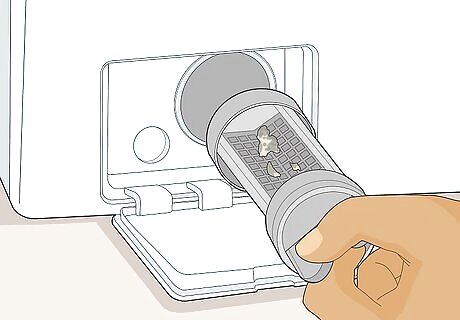
Clear out the washer’s filter when it’s clogged. If your washer leaves your clothes wet or the cycle takes longer than usual, then the filter may be clogged. Locate the access door in the bottom left or right corner at the front of the machine. Lay a towel and a shallow dish underneath the door and unscrew the filter lid. Let the excess water drain out into the dish. Then, pull the filter out and rinse it under running water. Use an old toothbrush to scrub away stuck debris before putting the filter back into your washer. The filter location may vary depending on your washer’s model, so check the manual if you’re having trouble finding it on your machine. EXPERT TIP Chris Willatt Chris Willatt House Cleaning Professional Chris Willatt is the owner and founder of Alpine Maids, a cleaning agency in Denver, Colorado started in 2015. Alpine Maids has received Angie's List Super Service Award for three years in a row since 2016 and has been awarded Colorado's "Top Rated Local House Cleaning" Award in 2018. Chris Willatt Chris Willatt House Cleaning Professional Chris Willatt, the owner of Alpine Maids, says: "In a front loader, the filter is usually in the bottom left corner of the machine. Once a month, clean out that filter to remove lint and old laundry detergent."
Maintaining a Front Load Washer
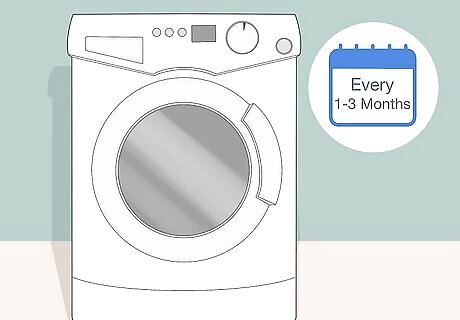
Clean your washer every 1–3 months. If you’re only running your washer once or twice a week, it’s okay to clean it out every 3 months. If you use your washer every day or run multiple loads throughout the week, then make time about once a month so you’re able to get rid of mold and mildew before it has a chance to form.
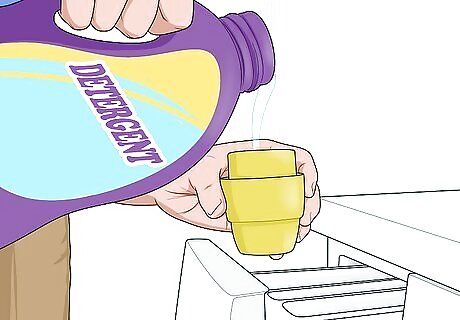
Use detergent made for high-efficiency machines. Purchase a high-efficiency detergent specifically designed for your washing machine so it doesn’t create too many suds. Only use the recommended amount of detergent for your load size. Using more detergent than you need can cause the soap to build up on your clothes and inside of your machine. Pod- and pack-style detergents are safe to use in front load washing machines. For large heavy loads, check the manufacturer’s instructions because they may recommend using 2 to 3 packs.
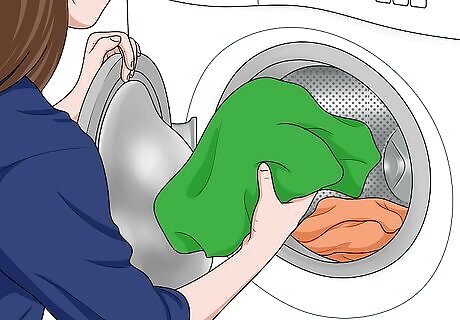
Remove your laundry right when the cycle finishes. Once you hear your washer finish the cycle, switch your laundry into your dryer or hang it up so it doesn’t sit in the drum. Otherwise, leaving your clothes in the drum could cause mildew or odors to form more easily. If you can't switch the load of wet laundry, like if you already have clothes in your dryer, at least crack the washer’s door open so moisture can escape.
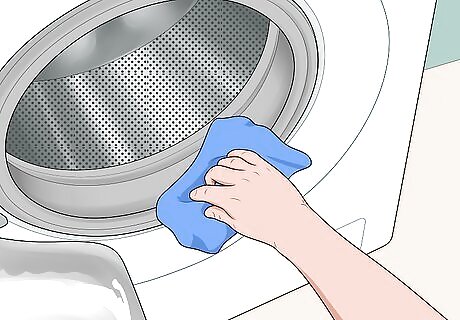
Dry the gasket and door in between loads. After you take clothes out of your washer, run an old towel around the gasket to wipe out any moisture and debris. Be sure to wipe the inside of the washer door as well so there isn’t any moisture. Leave the door open so fresh air can get inside your washer and prevent mildew from forming. Avoid leaving the washer door open if you have small children because they could climb inside and shut the door behind them.
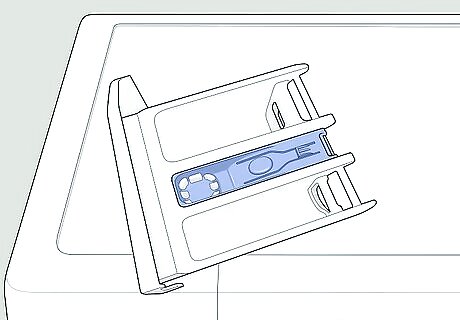
Remove and air dry the dispenser drawer after each use. As soon as the cycle finishes running, pull the dispenser drawer out and remove it completely if you’re able to. That way, you don’t trap any moisture so the drawer can dry out. As a bonus, opening the drawer also helps air move into the machine itself, which can make it dry out faster to prevent mold growth. Check the dispenser drawer for any mold or mildew growing on the surface each time you remove it.




















Comments
0 comment